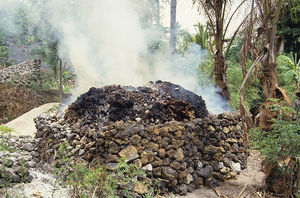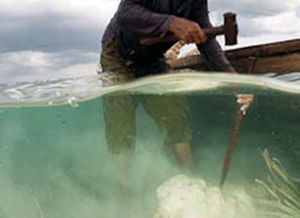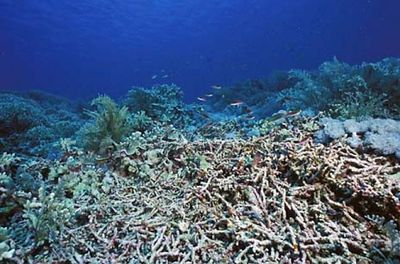Coral Mining
Coral Mining
Purpose of Mining

Coral is mined throughout the world for many purposes. The most common use of coral is to turn it into limestone or a cement substitute for use as a building material. In many island nations – a notable example being the Maldives, where a 1995 study showed that 20,000 cubic meters of coral/yr were collected solely for construction materials – this is the cheapest material to use to build their roads, houses, and seawalls [2]. Coral can also be made into calcium supplements or burned to produce lime. This lime production happens often in Australia, because their farmland is very acidic.Lime is needed to raise the pH of the soil, which can increase crop yields. The Great Barrier Reef provides a ready and available source of coral and is fairly cheap, since only a permit is required to harvest coral in specific areas. [3]. Jewelry made from coral is a popular tourist souvenir for those who do not realize the impact this has on the reef. Coral is often mined by locals to fashion into jewelry to sell to visitors. Coral is also useful in the medical field for bone graph clinical trials. Finally, live coral is harvested to be used by the marine aquarium industry [4].
Methods for Mining
Dynamite
One method to extract coral is to blast it with dynamite which breaks the coral up into smaller pieces that can be easily carried inshore [4]. This negatively affects a large area of the reef.

Manual
Another method is for collectors to manually retrieve the coral and break up the larger corals, using iron bars, into more manageable pieces to carry to the shore [3] [2].
Location of Mining
Coral mining can take place anywhere where coral is available in a convenient location such as off of cays in shallow water. Mining usually occurs at low tide when it is easier to gather the coral. Some prominent locations for mining activity include: the Great Barrier Reef [6], the Maldives [7][8], Panama [9], Indonesia [10], and East Africa [3].
Impacts of Mining

Loss in Biodiversity
One of the most significant effects of mining coral is that it causes a loss in biodiversity. By taking out chunks of coral and rock from the reef, substrate is lost. Therefore, any coral polyps that come to the area cannot attach themselves to permanent structures and recruitment is decreased. The simple act of removing and breaking up coral causes disturbance to the sea floor and leaves remnants behind. This causes increased sedimentation and any coral that is left may not survive due to the lack of sunlight and lower temperatures.
Erosion/Land Retreat
Coral reefs also act as protection to the land just beyond it. When a reef is partially or completely removed, the shore becomes more vulnerable to storms and other natural disasters. This can cause the land to retreat and impact the safety of any remaining parts of the reef. Surprisingly, the harvesting of live corals for the aquarium industry do not have much of an impact of the reef when done in an environmentally friendly manner (not removing all individuals in a populations, allows for regrowth/repopulation). This is because only pieces of coral are taken and much of the larger structure is left intact. The left over parts of the coral can regenerate, making harvesting somewhat sustainable, but only if sufficient time is left between harvests for the coral to regrow.
Slow Recovery
Reefs that have been mined extensively can take 20 years or more to recover. This is mainly due to the aforementioned loss in substrate and loss in biodiversity. Reefs have taken thousands of years to be built naturally, so it is not surprising to see long recovery times.
Economic Loss
In many locations around the world, coral reefs are used as a source of food and tourism. The fishing and tourism industries have been negatively affected by mining causing economic losses to communities that depend on them. For every $10 that is made from mining, the surrounding community actually loses $254. Even mismanaging 1 sq. kilometer of reef results in the loss of $6.6 million. However, it is estimated that each year, the value of material taken from reefs is $375 billion. This means that mining is very lucrative in the short term. It is the long term that needs to be focused on if coral reefs are to survive for future generations. [10]
Coral Mining Around the World
East Africa East African countries are beginning to prioritize conservation and management of coral reef resources. This is primarily done by increasing the number of Marine Protected Areas (MPAs), or areas in the ocean where human activity is strictly regulated for the purpose of conservation. However, this is occurring only after the corals have been severely damaged. In Kenya, Tanzania, and Mozambique, nearly 10% of coral reefs are almost completely or completely destroyed and unlikely to recover. Of the reefs that are still left standing, 30% in Kenya, and 20% in Tanzania and Mozambique are at high risk of becoming completely damaged to the point of no recovery. Some of these catastrophes are likely due to poor regulations. In fact, about 84% of MPA managers claimed to not have adequate funding for effective conservation.
Southeast Asia
Similarly, coral reefs in Southeast Asia are also experiencing detrimental effects from unsustainable human activity and poor management of MPAs. 50% of the coral reefs in Southeast Asia are at high threat levels, and only 12% remain at low risk. Considering that only 14% of Southeast Asia’s MPA’s have been considered “effectively managed”, this risk factor is likely to increase. In order to compensate for the lack of reef management, the “Reefs at Risk Project” was developed in SE Asia to raise awareness of indicators, causes and effects of coral reef damage.
The Carribean
The Caribbean has experienced similar problems to East Africa and Southeast Asia. Particularly in the Caribbean, reefs have been at high threat due to local communities farming and transporting corals. The Caribbean actually has the highest percentage of MPAs; however, less than 30% of these MPAs have been deemed successful or effectively managed. This is also primarily due to lack of resources and funding from the local and federal governments.
International Regulations
The Convention on International Trade in Endangered Species of Wild Fauna and Flora (CITES) is primarily responsible for the monitoring of trade. CITES has created a list of nearly 2,000 species of coral and fish that are in danger, with the goal of protecting them from international trade. The two levels of protection consist of: Appendix 1: Species in threat of extinction, trade only permitted on very rare occasions Appendix 2: Species that could potentially be threatened by trade (all coral species); regulated with permits for importers and exporters, as well as assessments on how trade of species affects the entire ecosystem The issue with this is that many countries do not have the resources to enforce CITES policies.
Ways to Improve Policy Evidently, policies on coral reef protection and funding for the enforcement of these policies must improve in order to prevent further demolition of the coral reefs. In order to do so, there must be a decrease in U.S. imports of wild coral reef species, an increase ecological reserves of coral reefs, established policies that limit harvesting to a more sustainable level, education of consumers about effects of coral mining, and opportunities for alternative careers for local communities.
Works Cited
Burke, Lauretta. “Reefs at Risk in Southeast Asia.” WRI Publications (2002): 1–72. World Resources Institute. Web. 3 Feb. 2016. <http://www.wri.org/publication/reefs-risk-southeast-asia>.
“Coral Reefs.” Washington College of Law. American University, 2016. Web. 3 Feb. 2016. <https://www.wcl.american.edu/environment/iel/sup3.cfm>.
Lucking, Mary Ann. “Federal Government Must Protect Caribbean Coral Reefs.” EarthJustice 14 Nov. 2013: n. pag. EarthJustice. Web. 3 Jan. 2016. <http://earthjustice.org/news/press/2013/court-federal-government-must-protect-caribbean-coral-reefs>.
Obura, David, and Julie Church. “Status of Coral Reefs in East Africa 2004: Kenya, Tanzania, Mozambique and South Africa.” Status of Coral Reefs of the World. 2004. 171–188. Marine Cultures. Web. 3 Jan. 2016. <http://www.marinecultures.org/static/files/cots/CORAL_REEFS_WIO.pdf>.
Rocliffe, Steve. “Marine Conservation Agreements in the Western Indian Ocean.” Protecting East Africa’s marine and coastal biodiversity (2007): 1–51. The University of York. Web. 3 Jan. 2016. <http://www.mcatoolkit.org/pdf/AfricaMCAFinal.pdf>.
Wolcott, Henry. “Coral Reef Mining, Harvest and Trade.” www.coral.org. The Coral Reef Alliance, 2005. Web. 3 Jan. 2016. <http://www.icran.org/pdf/CoralMiningIssueBrief.pdf>.
References
- ↑ www.flickr.com/photos/dkeats/5974551887/
- ↑ 2.0 2.1 Naseer, Abdulla. "Status of Coral Mining in the Maldives: Impacts and Management Options." Web. Accessed 20 Feb, 2013. <http://www.fao.org/docrep/X5623E/x5623e0o.htm>.
- ↑ 3.0 3.1 3.2 Nicholas K. Dulvy, Damon Stanwell-Smith, William R. T. Darwall and Chris J. Horrill Ambio. Coral Mining at Mafia Island, Tanzania: A Management Dilemma. Vol. 24, No. 6 (Sep., 1995), pp. 358-365. 20 Feb. 2013.
- ↑ 4.0 4.1 Coral Reef Alliance. "Mining and Harvesting". Web. Accessed 20 Feb, 2013. <http://www.coral.org/resources/issue_briefs/mining_and_harvesting>
- ↑ <http://coraltriangle.blogs.panda.org/coral-reefs/coral-miners>
- ↑ Daley, Ben, and Peter Griggs. "Mining The Reefs And Cays: Coral, Guano And Rock Phosphate Extraction In The Great Barrier Reef, Australia, 1844-1940." Environment & History (09673407) 12.4 (2006): 395-433. Environment Complete. Web. 20 Feb. 2013.
- ↑ Dawson Shepherd, Alec R, Warwick, Richard M., Clarke, K. Robert, & Brown, Barbara E. An analysis of fish community responses to coral mining in the Maldives. Environmental biology of fishes 33.4 01 Apr 1992: 367-380. Springer. 20 Feb. 2013.
- ↑ Clark, S., and AJ Edwards. "Use of Artificial Reef Structures to Rehabilitate Reef Flats Degraded by Coral Mining in the Maldives." Bulletin of Marine Science 55 (1994): 724-44. Articles +. 20 Feb. 2013.
- ↑ Guzmán, Héctor M., Carlos Guevara, and Arcadio Castillo. "Natural Disturbances And Mining Of Panamanian Coral Reefs By Indigenous People." Conservation Biology 17.5 (2003): 1396. Academic Search Complete. Web. 20 Feb. 2013.
- ↑ 10.0 10.1 Caras, Tamir, Pasternak, Zohar . Long-term environmental impact of coral mining at the Wakatobi marine park, Indonesia. Ocean & coastal management 52.10 2009: 539-544. Elsevier. 20 Feb. 2013.
- ↑ <http://www.oceanwideimages.com/categories.asp?cID=605>